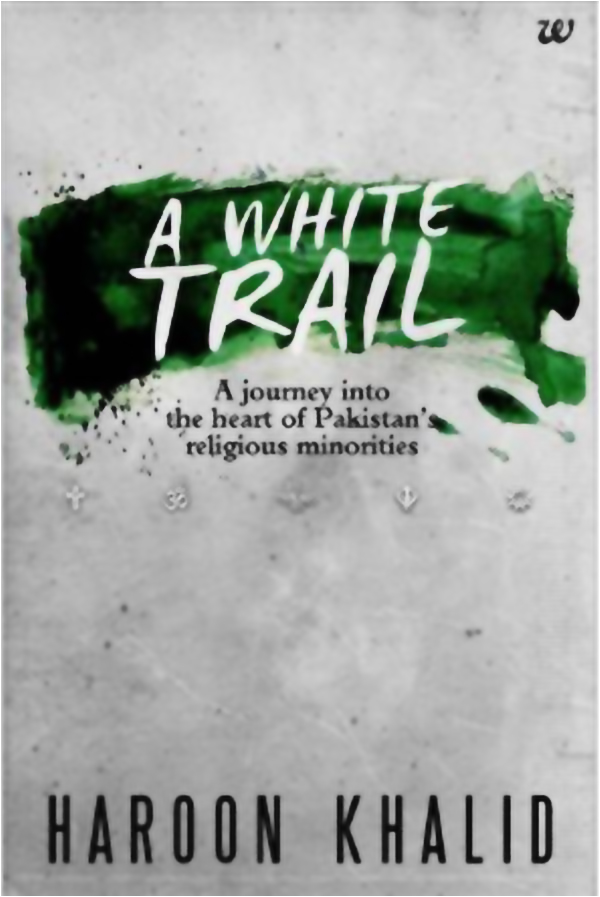
A White Trail by Haroon Khalid seeks to disaggregate the generalized narratives of victimhood surrounding the country’s minorities and replace them with a narrative derived from meaningful engagement with them. Taking up an ethnographic approach with a focus on oral history, Khalid uses his experiences at the major religious festivals of the Sikh, Christian, Hindu, Parsi and Baha’i communities in Punjab to attempt to give names and faces to these people and convey a more vivid sense of the lives they live and the challenges they face in a tone which falls prey to neither patronization nor sentimentality. Moving between the sonorous timbres of experiences at lively religious festivals such as Diwali, Holi, Vaisakhi and Navroz and the plangent tones of Hindus who have had to adopt Muslim names to attempt to blend into the society, Sikhs who are not allowed to eat or drink from the same utensils as Muslims and Christians who live in fear of the vicious and manifestly unjust Blasphemy Laws, Khalid’s book covers minorities’ experiences across a wide spectrum.

Alongside, it introduces a varied cross-section of the members of the minority communities under consideration, whose stories enrich the multiplicity of the narratives; from a Hindu activist holding a degree in Islamic Studies to a Protestant Christian with a PhD in Urdu Literature to a Sikh who has been commissioned in the army to Parvati Devi who barely escaped with her life from a mob looking to avenge the Babri Masjid incident. Then there is Kartar Singh who fled to Nankana Sahib from his home in Tirah valley after he was imagined to be an India agent when the 1971 war broke out, Baljeet Singh, a Pathan Sikh from the Khyber Agency who has fled to Punjab to escape persecution from the Taliban and Mary who was born an untouchable Hindu but wore a cross to escape being caught in the communal riots at the time of partition and now practices an arbitrary hybrid of Islam, Hinduism and Christianity.
From across all of these accounts emerge the remnants of a still extant common religious vocabulary as well as an undercurrent, albeit one that is ebbing, of syncretic religious traditions. Apart from the enforcement of the state’s definition of minorities as strictly compartmentalized categories which rendered plural identities difficult to maintain, the concern for security which has arisen over the last decade- and the resultant regulation of spaces - is one of the factors which are further endangering the existence of whatever little religious pluralism is left in the society. Whereas once Muslims could easily visit Sikh Gurdwaras and Hindu Temples during festivals and vice versa, this is no longer possible at most places.
[quote]Khalid's tone falls prey to neither patronization nor sentimentality[/quote]
A White Trail also reiterates the undeniably intertwined history and culture of Muslims and minority groups while pointing out how the quest for a reductionist Islamic identity crafted in opposition to infidel non-Muslims allows for minorities to be conceived of as a threatening abstraction against whom violence is justified. Although the beginnings of this process lay in the interpretation of the ‘Islamic identity’ of Pakistan, the rise of Islamization and fundamentalism in the country, in tandem with larger geopolitical issues, has compounded the hatred against minorities. By relaying personal accounts of the zeal and fervour with which Muslims razed to ground Hindu temples and looted Hindu homes to avenge the demolition of the Babri Masjid, the burning down of the Christian-populated village of Shanti Nagar, the public suicide of Bishop John Joseph in protest of the wrongful death sentence of Ayub Masih under the Blasphemy Law, the assassination of Salmaan Taseer and Shahbaz Bhatti for taking Aasia Bibi’s side, Khalid’s book holds up a mirror to the Pakistani society. This mirror shows us that the state’s complacency and complicity alone are not to blame for the maltreatment of minorities, but the society is also deeply complicit in these acts of violence, not least because of its unpardonable audacity in failing to look about and then forgetting and moving on.
Although somewhat grandiloquently sub-titled “A journey into the heart of Pakistan’s religious minorities,” the scope of A White Trail remains restricted to the province of Punjab, and therein too it deals with areas mostly in and around the city of Lahore. Additionally, in what seems to be an unexplained methodological slip-up, Khalid has dealt with the Ahmadiyya Community- although an intriguing and very relevant case of a persecuted minority community in Pakistan- in a single page containing the barest of details and appended to a chapter somewhere in the section on Sikhs. en.escortbayan.xxx
The tone of A White Trail is that of a travelogue with minimal authorial presence, a device which is effective in maintaining the neutrality required for the subject matter to affect the reader fully. The book is, however, written in thoroughly uninspiring prose which often veers into unnecessary, tepid and platitudinous descriptions, and newspaper-like flat reportage of events. Occasionally, Khalid also repeats some fact or information which has already been mentioned someplace earlier and there is also a distinct lack of analysis, especially across the minority communities. Despite Khalid’s claim in the introduction that the book would not merely be descriptive but also “delve deep into the history and mythology (of the events and rituals) and also attempt an anthropological and historical analysis,” this promise is not always consistently fulfilled. Although, certain relevant historical knowledge is given throughout the book, and the second half is distinctly better on this count than the first, there is no great depth to it and the reader feels that had the prose and analysis been tighter, A White Trail would have been a more rewarding book to read.
However, in navigating the ‘white trail’ and sharing his journey with us, Khalid has certainly managed to take a step towards marking the column of white on the Pakistani flag with a more varied and understanding picture.

Alongside, it introduces a varied cross-section of the members of the minority communities under consideration, whose stories enrich the multiplicity of the narratives; from a Hindu activist holding a degree in Islamic Studies to a Protestant Christian with a PhD in Urdu Literature to a Sikh who has been commissioned in the army to Parvati Devi who barely escaped with her life from a mob looking to avenge the Babri Masjid incident. Then there is Kartar Singh who fled to Nankana Sahib from his home in Tirah valley after he was imagined to be an India agent when the 1971 war broke out, Baljeet Singh, a Pathan Sikh from the Khyber Agency who has fled to Punjab to escape persecution from the Taliban and Mary who was born an untouchable Hindu but wore a cross to escape being caught in the communal riots at the time of partition and now practices an arbitrary hybrid of Islam, Hinduism and Christianity.
From across all of these accounts emerge the remnants of a still extant common religious vocabulary as well as an undercurrent, albeit one that is ebbing, of syncretic religious traditions. Apart from the enforcement of the state’s definition of minorities as strictly compartmentalized categories which rendered plural identities difficult to maintain, the concern for security which has arisen over the last decade- and the resultant regulation of spaces - is one of the factors which are further endangering the existence of whatever little religious pluralism is left in the society. Whereas once Muslims could easily visit Sikh Gurdwaras and Hindu Temples during festivals and vice versa, this is no longer possible at most places.
[quote]Khalid's tone falls prey to neither patronization nor sentimentality[/quote]
A White Trail also reiterates the undeniably intertwined history and culture of Muslims and minority groups while pointing out how the quest for a reductionist Islamic identity crafted in opposition to infidel non-Muslims allows for minorities to be conceived of as a threatening abstraction against whom violence is justified. Although the beginnings of this process lay in the interpretation of the ‘Islamic identity’ of Pakistan, the rise of Islamization and fundamentalism in the country, in tandem with larger geopolitical issues, has compounded the hatred against minorities. By relaying personal accounts of the zeal and fervour with which Muslims razed to ground Hindu temples and looted Hindu homes to avenge the demolition of the Babri Masjid, the burning down of the Christian-populated village of Shanti Nagar, the public suicide of Bishop John Joseph in protest of the wrongful death sentence of Ayub Masih under the Blasphemy Law, the assassination of Salmaan Taseer and Shahbaz Bhatti for taking Aasia Bibi’s side, Khalid’s book holds up a mirror to the Pakistani society. This mirror shows us that the state’s complacency and complicity alone are not to blame for the maltreatment of minorities, but the society is also deeply complicit in these acts of violence, not least because of its unpardonable audacity in failing to look about and then forgetting and moving on.
Although somewhat grandiloquently sub-titled “A journey into the heart of Pakistan’s religious minorities,” the scope of A White Trail remains restricted to the province of Punjab, and therein too it deals with areas mostly in and around the city of Lahore. Additionally, in what seems to be an unexplained methodological slip-up, Khalid has dealt with the Ahmadiyya Community- although an intriguing and very relevant case of a persecuted minority community in Pakistan- in a single page containing the barest of details and appended to a chapter somewhere in the section on Sikhs. en.escortbayan.xxx
The tone of A White Trail is that of a travelogue with minimal authorial presence, a device which is effective in maintaining the neutrality required for the subject matter to affect the reader fully. The book is, however, written in thoroughly uninspiring prose which often veers into unnecessary, tepid and platitudinous descriptions, and newspaper-like flat reportage of events. Occasionally, Khalid also repeats some fact or information which has already been mentioned someplace earlier and there is also a distinct lack of analysis, especially across the minority communities. Despite Khalid’s claim in the introduction that the book would not merely be descriptive but also “delve deep into the history and mythology (of the events and rituals) and also attempt an anthropological and historical analysis,” this promise is not always consistently fulfilled. Although, certain relevant historical knowledge is given throughout the book, and the second half is distinctly better on this count than the first, there is no great depth to it and the reader feels that had the prose and analysis been tighter, A White Trail would have been a more rewarding book to read.
However, in navigating the ‘white trail’ and sharing his journey with us, Khalid has certainly managed to take a step towards marking the column of white on the Pakistani flag with a more varied and understanding picture.

